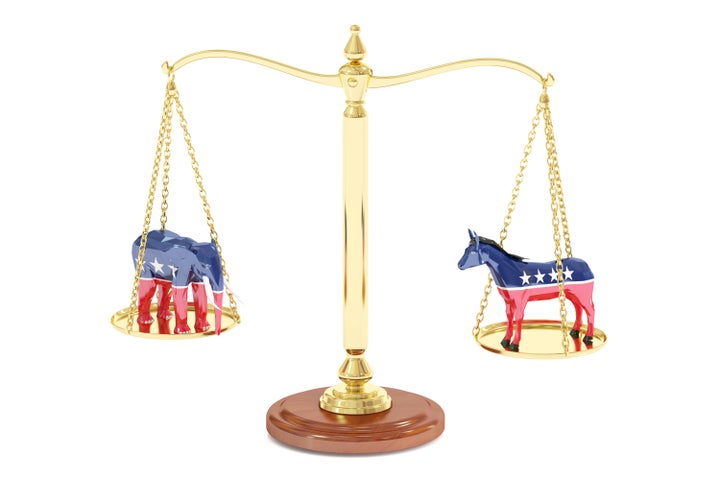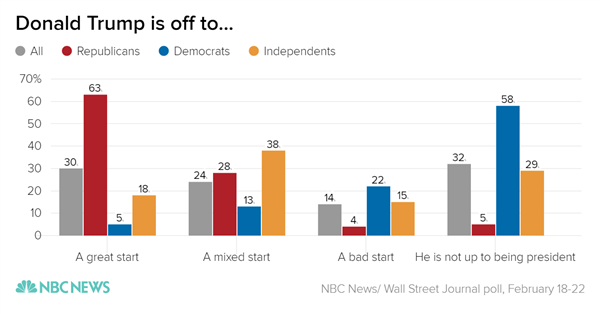
Republicans are increasingly happy with their own party. Teenagers are as disillusioned as their parents about politics. And the USC/LA Times pollsters take a post-mortem look at what went wrong in 2016. This is HuffPollster for Tuesday, February 28, 2017.
RATINGS FOR BOTH PARTIES CONVERGE - President Donald Trump, who previously condemned NBC’s polling as “fake,” found one number to like in the outlet’s latest survey, tweeting, “GOP now viewed more favorably than Dems, in Trump era (per NBC/WSJ poll).” The new survey finds that while Americans give the Republican Party a -8 net rating ― meaning they’re 8 points more likely to view it unfavorably than favorably ― they give Democrats an even more dire -16. [NBC/WSJ, via @realDonaldTrump]
HuffPost Pollster’s charts, which aggregate publicly-available polling, still give the Democrats a slight edge overall, but suggest a similar trend. Since last November’s election, the Democratic Party’s net favorability has fallen from an average of about -4 to about -10.
Republicans’ net favorability, meanwhile, have risen from about -19 to a comparatively healthy -13.
What’s changed? The GOP has been substantially boosted by increasing support from its own members. The latest YouGov/Economist poll, for instance, finds that Republicans now give their own party a net +71 rating, up from a +49 (among registered voters) in the final week of last year’s presidential election. Pew Research, which recently asked specifically about GOP leaders in Congress, also found Republicans’ approval for those leaders had more than doubled since 2015. [YouGov, Pew]
TRUMP GETS LOW RATINGS FOR HIS FIRST MONTH IN OFFICE - Carrie Dann with more on NBC/WSJ’s findings: “President Donald Trump’s job approval rating stands at just 44 percent — a record low for a newly inaugurated commander-in-chief — and half of Americans say that his early challenges suggest unique and systemic problems with his administration, according to a new poll from NBC News and the Wall Street Journal. In the poll, conducted February 18-22, 48 percent of Americans said they disapprove of Trump’s performance as president and 32 percent said that his first month in office demonstrates that he is not up to the job. Asked about early challenges in the first month of his presidency, 52 percent called the issues ‘real problems’ that are specific to his administration, while 43 percent of Americans attributed them to typical ‘growing pains’ for any new president…But despite his historically underwater public popularity, the survey also shows that his support from Republicans remains robust and that the public’s overall views of him are relatively stable.” [NBC]

Nearly half think Trump will create positive change - Chris Cillizza: “Almost 8 in 10 (77 percent) respondents said that Trump would bring about real change with 40 percent saying that it was ‘very’ likely he would do so….A near-majority of the country believes that Trump will bring the right kind of change while just 23 percent say he will bring about the wrong sort of change. And while Trump’s sky-high numbers among Republicans — 89 percent say he’s bringing the right kind of change — aren’t terribly surprising, the fact that independents are also much more willing to say he will bring the right change rather than the wrong type has to be encouraging for the Trump forces.” [WashPost]
TEENAGERS, LIKE MOST ADULTS, ARE DIVIDED ALONG POLITICAL LINES - Gillian Flaccus: “[A] new survey of children ages 13 to 17 conducted by The Associated Press-NORC Center for Public Affairs Research with the permission of their parents finds that America’s teens are almost as politically disillusioned and pessimistic about the nation’s divisions as their parents. The difference? They aren’t quite as quick to write off the future. Eight in 10 feel that Americans are divided when it comes to the nation’s most important values and 6 in 10 say the country is headed in the wrong direction….Just a quarter of teens say they have a lot in common with people of different political views. Three in four already have a party preference, including 29 percent who say they’ll be Democrats, 23 percent Republicans and 24 percent independent or another party. Less than one-third have a favorable impression of Trump, but only slightly more think well of Hillary Clinton.…Just 16 percent of teens feel the federal government is doing a good job promoting the well-being of all Americans, and not just special interests.” [AP, more from AP-NORC]
MOST AMERICANS TRUST THEIR FAVORITE NEWS OUTLETS OVER TRUMP - While previous surveys have found mixed results on whether the media as a whole is trusted over the president, a new poll suggests most voters have more faith in at least some specific outlets. Lindsay Wise and Sean Cockerham: “[D]espite Trump’s frequent blasts at the media, which he terms the enemy, the poll found that most voters trust their favorite news source over Trump, by a margin of 67 percent to 29 percent. The findings suggest that Trump has a credibility problem, said Lee Miringoff of the McClatchy-Marist Poll….Only 18 percent of voters said they trust Trump and his administration ‘a great deal’ to deliver accurate and factual information to the public. Forty percent said they don’t trust the president at all, and 17 percent don’t trust him very much….Forty-three percent of Trump supporters said Trump and his administration have not been tough enough on the media. Yet 66 percent of Democrats and 47 percent of independents said Trump has been too tough.” [McClatchy]
WHAT WENT WRONG WITH THE USC/LA TIMES POLL? - David Lauter: “Throughout the fall campaign, then-candidate Donald Trump and his allies loved the USC/L.A. Times “Daybreak” poll ― the only major survey that consistently showed him winning….But did the poll get it right? In the simplest terms, no, and after considerable analysis, the pollsters at USC have a good sense of why….The poll sample had too high a share of rural voters. That was an error, but in some ways a fortuitous one because it amplified the impact of precisely the voters who ended up delivering Trump’s victory in the key states. When the pollsters initially put together the sample of voters they surveyed, they got a random sample of voters spread equally among the country’s ZIP Codes. That’s a standard approach, but it has a potential flaw: ZIP Codes don’t all have the same population. More people crowd into the average urban ZIP Code than the average rural one. So if you draw equally from all ZIP Codes, you end up with too many rural residents represented….When the pollsters looked back at their data and adjusted it to have the proper shares of urban and rural Americans, the data showed Clinton narrowly winning the popular vote, as she, in fact, did.” [LAT]
HOW THE SAME POLL CAN GENERATE VERY DIFFERENT HEADLINES - Ipsos’ Chris Jackson: “We pollsters frequently make claims about the beliefs of ‘most Americans.’ We make these generalizations to help make complicated patterns in data easier to understand. However, in the reporting of our work, we often see these broad simplifications stretched to almost caricature-levels... Like all ‘truths’ in this age, public opinion has become a weapon for partisans on either side. But like all political combat, this tends to obscure more than it reveals. The reality is that Americans are not just simple statistics that can be easily inserted into a bar graph or Venn diagram. For example, on Feb. 1, Ipsos released polling numbers regarding American attitudes toward President Trump’s executive order halting immigration from certain nations. For our part, the numbers were surprising from a scientific standpoint; but nowhere near as surprising as how they were used to advance various narratives in the press….[T]he reality is that Americans hold complicated, sometimes contradictory opinions. Americans can both support a refugee ban and believe in civil liberties. Conversely, they can oppose the ban and support measures to prevent terrorism.” [The Hill]
HUFFPOLLSTER VIA EMAIL! - You can receive this daily update every weekday morning via email! Just click here, enter your email address, and click “sign up.” That’s all there is to it (and you can unsubscribe anytime).
TUESDAY’S ‘OUTLIERS’ - Links to the best of news at the intersection of polling, politics and political data:
-Amy Walter compares partisan divides in Donald Trump’s approval ratings to similar patterns in Barack Obama’s ratings. [Cook Political Report]
-Charles Franklin takes a closer look at mode and house effects on Trump’s approval ratings. [Medium]
-A majority of Americans ― including 80 percent of Democrats ― think Congress should investigate possible ties between the Trump campaign and Russia. [NBC]
-Byron York discusses shy Trump supporters with Republican pollster Neil Newhouse. [Washington Examiner]
-Kathleen Weldon uses data from the Roper Center to record the history of government provided health care. [HuffPost]
-Robert Bird and Frank Newport look at how Americans divide themselves into “lower,” “working,” “middle,” “upper-middle” or “upper” class. [Gallup]
-The Economist’s data team shows that Marine Le Pen leads the polls in the first round of the French presidential election but trails in the runoff. [Economist]
-Nearly 1 in 3 Americans say they’d leave Earth to escape the next four years of terrestrial politics. [HuffPost]
-Cookie bar charts > pie charts [@rachel_shorey]